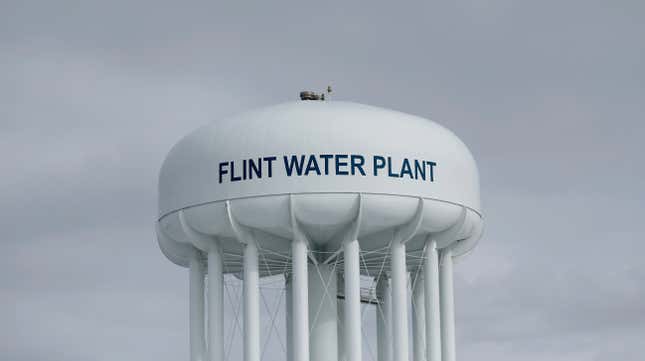
The people of Flint are finally getting some justice. The state of Michigan is dishing out $600 million in settlement dollars for victims of the water crisis that exposed the city of nearly 100,000 to unhealthy levels of lead in their drinking water.
First reported in the New York Times and confirmed by the legal team, the settlement was finalized on Thursday. The settlement was negotiated between a legal team at Cohen, Milstein, Sellers, and Toll, PLLC and state players, including the Michigan Department of Environmental Quality and former Gov. Rick Snyder. The $600 million will be accessible to residents and businesses affected by the crisis through direct payments from a court-monitored compensation fund. Nearly 80% of these dollars will go to children younger than 18 years old.
It comes more than six years after the crisis began to unfold. In 2014, city officials—led by state-appointed emergency manager Darnell Earley—switched Flint’s water source irresponsibly and without the proper treatment measures in place. As a result, the water caused corrosion to the pipes it traveled through, leaching lead into the city’s water supply. The city and state took more than a year to declare a state of emergency and supply residents with free bottled water.
Since then, a number of different lawsuits have popped up, some on behalf of residents and others on behalf of the state. This settlement, however, comes after thousands of residents sued state and local government officials as part of a class-action lawsuit in 2016. They alleged that public and private officials created the health crisis of lead-tainted water. The Supreme Court allowed the case to move forward only just this year, but the negotiations for the settlement have been going on for more than a year, the Times reports. Anyone who had lived in the city between 2014 and 2016 may be eligible for a claim, which should be available by spring 2021, per the Times. It seems like the state is finally ready to take some responsibility and pay up for the crisis. The attorneys will continue the legal battle, however, against other defendants, including the private engineering firms that helped contribute to the crisis by giving the city poor advice.
Not all cases have been resolved in favor of community members, though. The state attorney general’s office dropped all criminal charges last year related to one of the deaths the crisis caused, leaving the public confused. That investigation looked at the impacts beyond the lead, though. The toxic metal wasn’t the only thing in the water; a dangerous bacteria was, too. Legionella pneumophila can lead to Legionnaire’s disease, a severe form of pneumonia, and it killed at least 12 people during the crisis. The state dropped the charges related to one of those deaths, but it appears justice is still happening elsewhere.
The main theme among these lawsuits have been around the exposure to lead—and the mishandling of the crisis by city officials. Lead is toxic and consuming it can cause potentially lifelong impacts, especially for young children. It can lead to developmental issues and delayed puberty. In a predominantly Black low-income community, children are already at a disadvantage. Crime is another problem residents in the city have to face. Some studies have drawn links between lead exposure and increased violent crime, likely due to the mental impacts lead has on individuals. All of this is a symptom of systemic racism, which has left poor communities of color with insufficient resources after years of government negligence. The water crisis, however, could set these kids back even further, showing the compounding nature of environmental racism.
And make no mistake, that’s exactly what happened in Flint. Residents complained about brown water and rashes that appeared on their kids’ skin after bathing for months before anyone listened. Even then, though, the response was slow and haphazard. Officials even tried to discredit a local doctor who spoke out about the crisis, Mona Hanna-Attisha. These types of problems simply do not happen in white wealthy communities. If they do somehow, they are fixed with an urgency communities of color can only dream of.
No amount of money can erase the pain and trauma of this event for the people who lived through it, but it’s a start. Maybe our leaders should prioritize investigating the players who allowed this mess to happen in the first place.